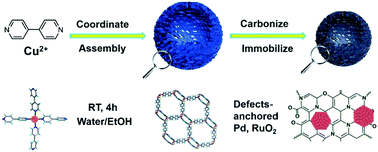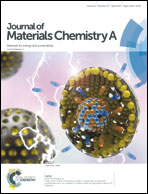Highly dispersed metal and oxide nanoparticles on ultra-polar carbon as efficient cathode materials for Li–O2 batteries†
Abstract
Li–O2 batteries trigger worldwide interest as promising candidates for future energy supplies. One of the major challenges regarding current Li–O2 batteries is exploring highly efficient cathodes with sophisticated structures and compositions. Herein, highly dispersed metal (Pd) or oxide (RuO2) nanoparticles on ultra-polar carbon are synthesized and employed as cathode materials for Li–O2 batteries. The hierarchically porous structure of the carbon facilitates the oxygen diffusion and electrolyte impregnation and provides enough space to accommodate the discharge products. More importantly, the porous carbon with the ultra-polar surface serves as an efficient support for distinct dispersion of Pd or RuO2 nanoparticles which not only greatly enhances the catalytic activity but also eases side reactions by passivating the carbon defects. By virtue of the hierarchical structure associated with the extremely high dispersion of active particles, the battery performance is effectively enhanced by greatly prolonging the cycle life and significantly lowering the overvoltages especially for the charging process. The encouraging results suggest that such ultra-polar hierarchical carbon-based composites can be appealing materials for rechargeable Li–O2 batteries.



 Please wait while we load your content...
Please wait while we load your content...